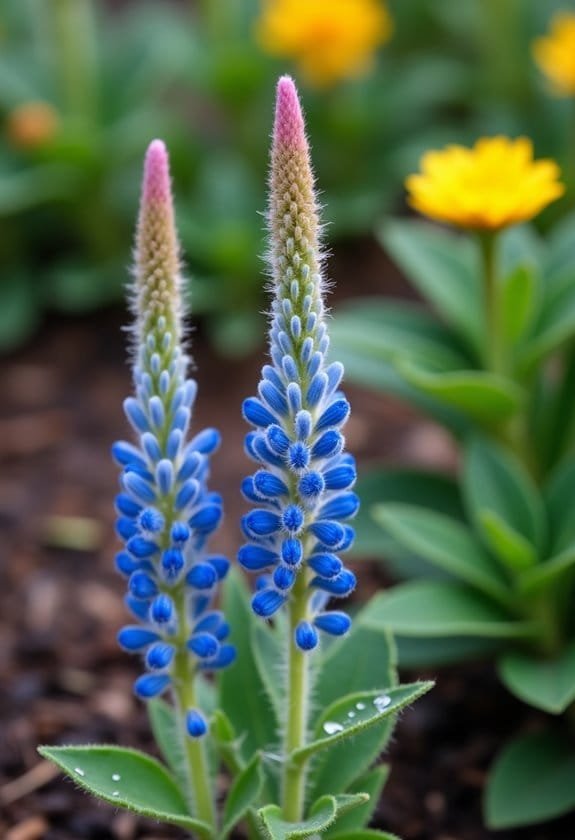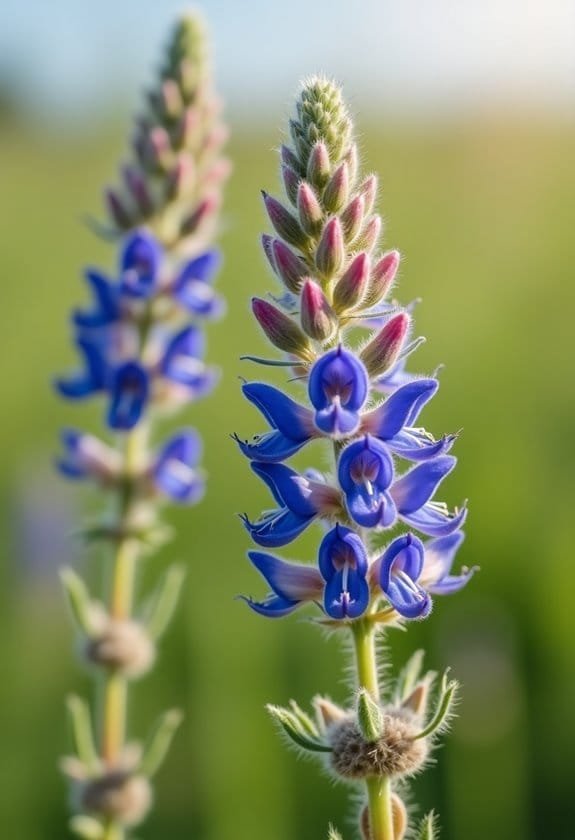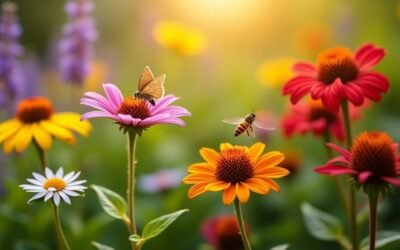Echium vulgare, commonly called Viper's Bugloss, is a resilient biennial flowering plant reaching heights of 12-31 inches. It's distinguished by red-flecked stems resembling snake skin and bell-shaped flowers that shift from pink to vibrant blue during its May-to-September bloom period. This European native has naturalized across multiple continents, thriving in well-drained, poor soils with full sun exposure. The plant's extended flowering season and abundant nectar production make it an essential pollinator magnet, though it contains toxic alkaloids requiring careful handling. While its self-seeding nature can be aggressive, proper management reveals the full potential of this remarkable species.
Main Points
- Echium vulgare is a biennial flowering plant reaching 12-31 inches tall, with distinctive red-flecked stems resembling snake skin.
- The plant produces bell-shaped flowers that change from pink to blue, blooming from late spring through early fall.
- Native to Southern Europe, it thrives in full sun and well-drained soil, displaying exceptional drought tolerance once established.
- Important pollinator plant attracting bumblebees and butterflies, but contains toxic alkaloids harmful to horses and can irritate human skin.
- Self-seeding capability and adaptability to poor soils make it both resilient and potentially invasive in certain regions.
Introduction

Echium vulgare, commonly known as Viper's Bugloss, stands as a remarkable biennial plant that has captured attention with its striking violet-blue flowers and distinctive rough foliage.
This European native has established itself across multiple continents, from the Americas to New Zealand, demonstrating its remarkable adaptability to various climates and soil conditions.
The plant's scientific designation stems from its unique nutlets, which resemble viper heads, while its growth pattern typically produces flowering stems reaching heights between 12 to 31 inches, creating an impressive display in gardens and natural landscapes.
Common Name
The widely recognized Viper's Bugloss, also known as Blueweed or Blue Thistle, is the common name for Echium vulgare. This distinctive plant earned its intriguing common name through a fascinating botanical feature: its nutlets bear a striking resemblance to viper heads, creating an immediate visual connection to these serpents.
Despite the snake-related common name, it's essential to understand that the plant doesn't actually attract vipers or any other snakes to its habitat. Instead, the common name serves as a descriptive reference to the plant's physical characteristics, particularly its seed-bearing structures.
The plant's alternative common names, Blueweed and Blue Thistle, derive from its most prominent feature: the striking violet-blue flowers that emerge in dense spikes during its blooming period from late spring through early fall.
While originally native to Southern Europe, the plant's distribution has expanded considerably, and these common names have followed it as it naturalized in various regions, including North America and New Zealand, where it's now well-established in local ecosystems.
Scientific Name
Beyond its familiar common names, this distinctive plant carries the scientific name Echium vulgare, which originates from the Greek word "echis," meaning viper. This scientific designation perfectly captures one of the plant's most distinctive features: its nutlets, which bear a remarkable resemblance to a viper's head, demonstrating the thoughtful nature of botanical nomenclature.
The placement of Echium vulgare within the Boraginaceae family provides essential taxonomic context, connecting it to a broader group of flowering plants that share similar structural characteristics and growth patterns. This classification has significant implications for understanding the plant's biological relationships and evolutionary history within its family group.
While the species naturally occurs across Southern Europe and temperate Asia, its adaptability has enabled successful naturalization in diverse regions, including North America, South America, and New Zealand. The scientific name has remained consistent across these geographical expansions, serving as a universal identifier that transcends regional variations in common names and facilitates precise scientific communication about this remarkable plant species.
Overview
Standing proudly in gardens and meadows across Europe and Asia, Viper's Bugloss commands attention with its striking violet-blue flowers and distinctive hairy stems. This remarkable biennial plant, reaching heights of 12-30 inches, showcases an array of blossoms adorned with prominent red stamens that emerge from late spring through early fall.
Viper's Bugloss has earned its intriguing name from its fruit's resemblance to snake heads, while its resilient nature allows it to flourish in challenging environments. The plant's exceptional drought resistance and preference for well-drained soils make it particularly suited to coastal regions and unimproved grasslands, where it establishes itself with remarkable tenacity through self-seeding.
While this hardy plant serves as a valuable resource for pollinators and contributes to local biodiversity, its vigorous growth patterns have led to its classification as invasive in certain regions, including Washington state.
Gardeners and agriculturalists should note that the plant contains toxic alkaloids, which can cause mild poisoning if ingested and may trigger skin irritation upon contact, particularly affecting equine populations.
Key Features
Echium vulgare's striking appearance stems from its upright growth pattern, reaching impressive heights between 12 and 30 inches with distinctive red-flecked stems that mimic snake skin.
The plant's rough, hairy oblanceolate leaves complement its most enchanting feature: dense spikes of bell-shaped violet-blue flowers that bloom prolifically from late spring through early fall.
After flowering, the plant produces peculiar nutlets that bear an uncanny resemblance to viper heads, adding to its already intriguing visual character and contributing to its common name, Viper's Bugloss.
Growth Size
The striking Viper's Bugloss commands attention with its impressive height of 12 to 30 inches (30 to 75 cm). As a biennial plant, it develops through a distinctive two-stage growth pattern, initially forming a ground-level rosette of rough, hairy leaves during its first year.
In its second year of growth, the plant reaches its full flowering potential, stretching upward with remarkable vigor to achieve its maximum height. The stems, which bear a distinctive red-flecked pattern reminiscent of snake skin, support dense spikes of bell-shaped blooms measuring 15 to 20 millimeters in length.
These flowers shift through a fascinating array of colors, from delicate pink to intense blue, creating a vertical display that enhances the plant's commanding presence.
The oblanceolate leaves maintain their characteristic hairy texture throughout the growth cycle, contributing to the plant's robust appearance. As a monocarpic perennial, Viper's Bugloss invests its energy in this singular, magnificent growth phase, producing an upright structure that serves as both a visual focal point and an important ecological resource in its native habitat.
Appearance
With five striking features, Viper's Bugloss captivates observers through its distinctive appearance. The plant's most remarkable characteristic is its dense spike of bell-shaped flowers, which undergo a mesmerizing transformation from pink buds to vivid blue blooms measuring 15-20 mm in length.
The flowers' dramatic display is enhanced by prominent red stamens that protrude from the blue petals, creating a stunning visual contrast that attracts both pollinators and admirers.
Adding to its unique character, the plant's stems exhibit a remarkable red-flecked pattern reminiscent of snake skin, while its rough, hairy leaves showcase an oblanceolate form adorned with distinctive white speckles against their green backdrop.
The plant's namesake feature emerges after the flowering period, when it produces rough nutlets bearing an uncanny resemblance to viper heads. This characteristic, combined with the snake-like appearance of its stems, reinforces the historical connections between Echium vulgare and its common name, Viper's Bugloss, while contributing to its enduring appeal in both ornamental and naturalized settings.
Flowering Season
During late spring through early fall, Viper's Bugloss bursts into vibrant bloom, reaching its peak flowering period between May and September. The plant's remarkable flowering season features an enchanting transformation, as delicate pink buds gradually unfold into striking blue flowers that measure 15-20 mm in length.
Throughout its extended blooming period, Viper's Bugloss creates an impressive display of bell-shaped blossoms adorned with prominent red stamens, which emerge in dense, elongated spikes along the plant's stems. This dramatic color progression, from soft pink to intense blue, guarantees the plant maintains visual interest throughout its entire flowering season.
The abundance of blue flowers serves a vital ecological purpose, attracting diverse pollinators that contribute to local biodiversity. As the flowering season progresses toward early fall, the plant's reproductive cycle culminates in the formation of distinctive nutlets, which bear an uncanny resemblance to viper heads.
These unique seed structures persist after the blooming period ends, providing both visual interest and securing the plant's successful reproduction for subsequent growing seasons.
Growing Requirements

Vipers bugloss requires full sun exposure and well-drained soil to achieve its striking display of blue flowers and robust growth.
The plant's exceptional drought tolerance makes it an ideal choice for xeriscaping, though occasional supplemental watering during prolonged dry spells helps maintain its vigor.
Its adaptability to average or poor soils, combined with its preference for temperatures between 60-75°F, makes it a remarkably resilient addition to gardens across diverse climate zones.
Light
Full sun exposure is essential for Echium vulgare to thrive, requiring a minimum of 6 hours of direct sunlight daily. This sun-loving plant demonstrates remarkable adaptability to bright conditions, which directly influences its growth patterns and flowering success.
In ideal sunny locations, Viper's bugloss reaches its full potential, developing into robust specimens that can grow between 12 to 30 inches tall. The intense sunlight triggers the production of dense flower spikes, creating spectacular displays of bell-shaped blooms during its second-year flowering phase.
The plant's biennial nature makes proper light exposure particularly important throughout both its vegetative and reproductive stages.
The relationship between full sun exposure and soil conditions plays a significant role in the plant's development. While Viper's bugloss shows exceptional drought tolerance in sunny positions, it actually performs better in less fertile soils when receiving abundant sunlight.
This adaptation makes it an excellent choice for sun-drenched garden spots where other plants might struggle, particularly in areas prone to extended dry periods or locations with consistent, unobstructed sunlight throughout the growing season.
Soil
Well-drained soil forms the foundation of Echium vulgare's growing requirements, with the plant showing a distinct preference for average to poor soil conditions. This remarkable adaptability to less fertile environments makes it an exceptional choice for gardeners dealing with challenging growing conditions, particularly in areas where other ornamental plants might struggle to establish themselves.
In contrast to many garden favorites that demand rich, nutrient-dense soil, Viper's Bugloss actually performs better in poor soils with minimal organic matter. The plant's robust root system enables it to thrive in various substrate types, from coastal sandy soils to rocky, unimproved grasslands, while excessive fertility can paradoxically inhibit both flowering and overall growth patterns.
This adaptive characteristic aligns perfectly with its drought-resistant nature, as well-drained, lean soils promote stronger root development and more prolific blooming cycles. While the plant's self-seeding tendency requires occasional monitoring, especially in garden settings, its ability to establish itself in challenging soil conditions demonstrates its remarkable resilience without becoming problematically invasive in most geographical regions.
Water
Adaptability to dry conditions stands as one of Echium vulgare's most notable characteristics, making it an excellent choice for water-conscious gardening. This remarkable plant has evolved to thrive in environments where water resources are limited, demonstrating exceptional drought tolerance once established in the landscape.
While Viper's Bugloss exhibits impressive resilience to dry spells, it still benefits from thoughtful water management during its growing cycle. During periods of extreme drought, occasional supplemental watering helps maintain the plant's vibrant appearance and supports continuous blooming, though it's essential not to overwater.
The key to success lies in finding the sweet spot between moisture provision and the plant's natural drought-resistant tendencies.
Gardeners should monitor soil moisture levels during the first growing season, providing moderate water to help establish a robust root system. Once the plant has developed strong foundations, it requires minimal irrigation intervention, making it an ideal candidate for xeriscaping projects and low-maintenance garden designs.
The plant's water efficiency aligns perfectly with sustainable gardening practices, offering both ecological benefits and reduced maintenance demands.
Temperature
Beyond its water-wise nature, Echium vulgare exhibits remarkable temperature tolerance across diverse climate zones. This adaptable biennial thrives in hardiness zones 3 through 8, demonstrating exceptional resilience to both winter's chill and summer's warmth. The plant's robust constitution enables it to withstand temperature fluctuations that would challenge less hardy species.
During its first year of growth, Echium vulgare develops a deep taproot system that helps regulate its temperature exposure by anchoring it firmly in the soil's more stable thermal layers. This adaptation proves particularly valuable in regions where surface temperatures can vary dramatically between seasons.
The plant's preference for full sun exposure indicates its ability to tolerate high temperatures, provided it receives at least six hours of direct sunlight daily. While it flourishes in warm conditions, its broad hardiness zone range suggests it can equally endure cold winters, making it a versatile choice for gardens in various climates.
The plant's inherent drought resistance further enhances its temperature adaptability, as it can maintain healthy growth even during hot, dry spells without showing signs of stress.
Pollinator Criteria
Viper's Bugloss stands as a remarkable pollinator magnet, attracting an impressive array of insects with its color-changing flowers that shift from pink buds to vibrant blue blooms.
The plant's specialized bell-shaped flowers, arranged in dense spikes, create an ideal landing platform for various pollinators, including bees, butterflies, and skipper moths, which visit from May through September.
These beneficial insects, particularly skipper butterflies, guarantee
Attracted Pollinators
Through its vibrant blue flowers and dense flowering spikes, Echium vulgare serves as a powerful magnet for diverse pollinators throughout its blooming season. The plant's distinctive bell-shaped blooms, adorned with protruding red stamens, create an irresistible beacon for numerous beneficial insects seeking nectar-rich resources.
Among the most frequent visitors are various species of bees, particularly bumblebees, which are drawn to the plant's abundant nectar production from late spring through early autumn. Butterflies and skippers also regularly frequent these flowering spikes, contributing to the plant's role in supporting local pollinator populations. The presence of specialized visitors like burnet moths further emphasizes the plant's ecological significance in maintaining biodiversity.
The plant's drought-resistant nature guarantees consistent nectar availability even during challenging environmental conditions, making it an invaluable resource for pollinator communities in dry or water-stressed areas.
This reliability, combined with its extended flowering period and high nectar production, establishes Viper's Bugloss as a cornerstone species for pollinator-friendly gardens and natural landscapes.
Pollination Method
The pollination success of Echium vulgare relies on specific flower characteristics that target ideal pollinators. The plant's strategic color transformation, from pink to brilliant blue blooms, serves as a sophisticated visual signal that guides skipper butterflies to their nectar reward.
Viper's Bugloss employs a particularly effective pollination method through its distinctive bell-shaped flowers, which are perfectly suited to accommodate visiting pollinators. The protruding red stamens create a striking contrast against the blue petals, functioning as natural landing platforms for insects seeking nectar.
This architectural design guarantees that pollinators must brush against the reproductive structures while feeding, facilitating efficient pollen transfer.
The timing of the plant's flowering period strategically aligns with peak pollinator activity in the Northern Hemisphere, maximizing reproductive success from late spring through early fall. By providing both nectar and pollen resources, the plant maintains a mutually beneficial relationship with various pollinating insects, though skippers remain the primary visitors.
This specialized pollination system contributes considerably to local ecosystem health, supporting diverse insect populations while guaranteeing successful reproduction of the species.
Care & Maintenance

Vipers bugloss thrives with minimal intervention when planted in well-draining soil with full sun exposure, requiring supplemental water only during prolonged drought periods.
Maintaining these hardy biennials involves regular deadheading of spent blooms, which prevents aggressive self-seeding and encourages the development of secondary flower spikes throughout the growing season.
Gardeners should monitor the plant's tall flower stalks, providing support when necessary, and manage any volunteer seedlings that emerge beyond the intended growing area to maintain a controlled garden aesthetic.
Planting Tips
Growing Echium vulgare successfully requires attention to a few key care requirements. When selecting a planting location, gardeners should prioritize areas that receive abundant sunlight throughout the day, as Viper's bugloss thrives in full sun exposure.
The soil conditions play a vital role in the plant's establishment and subsequent growth. Well-draining soil is essential for ideal development, and gardeners should avoid areas where water tends to pool or collect.
While the plant demonstrates remarkable drought tolerance once established, it's beneficial to provide supplemental watering during the initial growing phase and periods of extreme drought. However, it's important to resist the temptation to enrich the soil with fertilizers, as nutrient-rich conditions can actually diminish flowering performance.
When planting, space individual specimens approximately 18-24 inches apart to accommodate their mature size and allow adequate air circulation. To manage the plant's vigorous self-seeding tendency, consider incorporating barriers or selecting a contained garden area.
Spring planting proves most successful, allowing the roots to establish before summer's heat arrives, while autumn planting should be avoided in regions with harsh winters.
Ongoing Care
Maintaining Echium vulgare in your garden calls for minimal intervention throughout the growing season. The rugged nature of Viper's Bugloss enables it to thrive in well-drained, average to dry soils, particularly when positioned in full sun exposure, making it an exceptionally low-maintenance addition to any landscape.
The ongoing care primarily focuses on selective maintenance tasks that enhance the plant's health and control its spread. During prolonged dry spells, occasional watering helps sustain the plant's robust appearance and overall well-being.
Deadheading becomes essential as blooms fade, serving the dual purpose of preventing excessive self-seeding and maintaining the garden's aesthetic appeal. Regular monitoring for volunteer seedlings guarantees the plant's spread remains within desired boundaries, though its self-seeding tendency rarely becomes problematic.
As winter shifts to spring, implementing a strategic cut-back of the plant promotes vigorous growth and abundant flowering in the subsequent season. This simple yet effective maintenance routine allows gardeners to enjoy Viper's Bugloss's striking blooms while keeping its naturally enthusiastic growth habits in check.
Suggested Companions
Successfully pairing Echium vulgare with compatible companion plants enhances both its visual appeal and ecological benefits in the garden. Drought-resistant plants like lavender and yarrow make excellent neighbors for Viper's Bugloss, as they share similar requirements for well-drained soil and full sun exposure.
When designing the garden layout, consider height variations to create visual interest. Shorter companions such as coreopsis and creeping thyme work beautifully when positioned in front of Viper's Bugloss, which typically reaches heights of 30 inches or more. This tiered arrangement creates an aesthetically pleasing display while maximizing space utilization.
To maintain harmony among companion plantings, regular deadheading of Viper's Bugloss is essential to prevent aggressive self-seeding.
The addition of pollinator-friendly plants like bee balm and coneflowers amplifies the garden's ecological value, creating a vibrant hub for beneficial insects. These complementary species work together to form a sustainable microhabitat, where each plant contributes to the overall health and significance of the garden ecosystem while thriving in similar environmental conditions.
Common Issues
While Vipers Bugloss demonstrates remarkable resilience to most garden pests, it can face challenges from persistent slug damage and potential toxic reactions in humans and animals who handle or consume it.
The plant's robust nature means bacterial and fungal diseases rarely pose significant threats, though proper spacing between plants helps maintain adequate air circulation and prevents any minor issues from spreading.
Gardeners should focus on managing the plant's aggressive self-seeding tendencies and avoid over-fertilization, which can compromise its natural flowering cycles and contribute to unwanted spread in the garden.
Pests/Diseases
Echium vulgare stands out as a remarkably disease-resistant plant, requiring minimal intervention for pest control. Its natural defenses, including bristly hairs and toxic alkaloids, create an effective barrier against most potential threats, particularly deterring mammalian grazers from consuming its foliage.
While the plant demonstrates impressive resilience, it's not entirely immune to all challenges. Slugs represent the primary pest concern, occasionally targeting young growth and tender leaves during damp conditions. The plant's bristly exterior, which serves as a defensive mechanism, can ironically pose a risk to gardeners, potentially causing contact dermatitis in sensitive individuals who handle the plant without proper protection.
Perhaps the most significant management consideration isn't related to traditional pests or diseases but rather the plant's vigorous self-seeding tendency. This characteristic, while beneficial for naturalization, requires monitoring to prevent unwanted spread throughout gardens or natural areas.
Despite these minor challenges, Viper's Bugloss maintains its reputation as a low-maintenance option that typically thrives without significant intervention, making it an attractive choice for gardeners seeking robust, self-sufficient plants.
Solutions
Gardeners can effectively manage common issues with Viper's Bugloss through simple preventive measures. The most vital maintenance task for Echium vulgare involves controlling its self-seeding tendencies by removing flowering spikes before seed production occurs, which helps maintain the plant's presence within desired garden boundaries.
During periods of extreme drought, while this hardy plant demonstrates remarkable resilience, supplemental watering becomes necessary to preserve its distinctive appearance and robust health.
Implementing protective barriers or applying organic slug deterrents helps safeguard against these occasional gastropod visitors, which can damage young growth and foliage. When the plant's characteristic tall spikes begin to show signs of instability, strategic pruning of the main stems encourages lateral growth development, resulting in a more compact and structurally sound specimen.
Given the bristly nature of Echium vulgare's foliage, gardeners should exercise caution during maintenance activities by wearing appropriate protective gloves, as the plant's stiff hairs can cause mild skin irritation in sensitive individuals.
This straightforward approach to plant care guarantees a thriving display while minimizing potential complications.
Summary

Known commonly as Viper's Bugloss, this striking biennial plant grows up to 30 inches tall and produces vibrant violet-blue flowers with distinctive red stamens. Native to Southern Europe and parts of Asia, this resilient species has successfully naturalized across North America, though its aggressive spread has led to its classification as invasive in certain regions.
The plant's remarkable drought resistance and preference for well-drained soils make it an excellent choice for low-maintenance gardens, where it provides reliable blooms from May through September. Its bell-shaped flowers attract essential pollinators, while its unique nutlets, resembling small viper heads, add visual interest to the garden after flowering.
However, gardeners should exercise caution when handling Viper's Bugloss, as it can cause skin irritation in sensitive individuals. To maintain control over this vigorous self-seeder, regular deadheading is recommended before seed dispersal occurs.
While its wildlife-friendly characteristics and drought tolerance make it an attractive option for naturalized gardens, careful consideration should be given to its placement, particularly in areas where horses might graze, due to its toxic properties.


